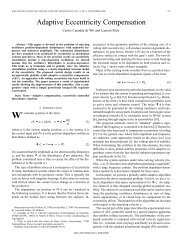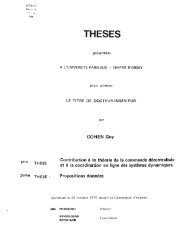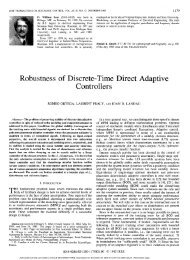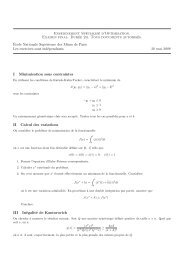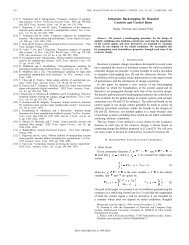HOMOGENEOUS OBSERVER DESIGN 1821In the context <strong>of</strong> homogeneity in the ∞-limit, we have the following result.Proposition 2.18. Consider a homogeneous in the ∞-limit vector field f :R n → R n with associated triple (r ∞ , d ∞ ,f ∞ ). If the origin <strong>of</strong> the systemẋ = f ∞ (x)<strong>is</strong> globally asymptotically stable, then there ex<strong>is</strong>ts an invariant compact subset <strong>of</strong> R n ,denoted C ∞ , which <strong>is</strong> globally asymptotically stable 3 for the systemẋ = f(x) .The pro<strong>of</strong> <strong>of</strong> the proposition <strong>is</strong> given in Appendix D.As in the case <strong>of</strong> homogeneity in the 0-limit, <strong>th<strong>is</strong></strong> property can be used to designa feedback, ensuring boundedness <strong>of</strong> solutions.Example 2.19. Consider the system (1.1) with 0 < q < p < 2 and the controllaw(2.6) u = − 1(2 − p x p−12−p1 x 2 − x p2−p1 − c ∞ x p 2 −x 2 + x 12−p1) p.Th<strong>is</strong> control law <strong>is</strong> such that the closed-loop vector field <strong>is</strong> homogeneous in the ∞-limitwith degree d ∞ = p − 1, weight (2 − p, 1), and associated vector field f ∞ (x 1 ,x 2 )=(x 2 , − 12−p x p−12−p1 x 2 − x p2−p1 −(x 2 + x 12−p1 ) p ) T . For the homogeneous Lyapunov function<strong>of</strong> degree 2,V ∞ (x 1 ,x 2 ) = 2 − p2 1|x 1 |2−p + 22 ∣ x 2 + x 12−p1 ∣2,we get∂V ∣ ∣∣∣ ∞∂x (x) f ∞(x) = −|x 1 | p+12−p − x 2 + x 112−p∣p+1.It follows that the control law (2.6) guarantees boundedness <strong>of</strong> the solutions <strong>of</strong> theclosed-loop system. Furthermore, boundedness <strong>of</strong> solutions <strong>is</strong> preserved in the presence<strong>of</strong> any perturbation which does not change the approximating homogeneousfunction in the ∞-limit, i.e., in the presence <strong>of</strong> perturbations which are negligiblewith respect to the dominant homogeneous part (see P2 in section 2.2).The key step in the pro<strong>of</strong> <strong>of</strong> Propositions 2.16 and 2.18 <strong>is</strong> the converse Lyapunovtheorem given <strong>by</strong> Rosier in [29]. Th<strong>is</strong> result can also be extended to the case <strong>of</strong>homogeneity in the bi-limit.Theorem 2.20 (homogeneous in the bi-limit Lyapunov functions). Considera homogeneous in the bi-limit vector field f : R n → R n , with associated triples(r ∞ , d ∞ ,f ∞ ) and (r 0 , d 0 ,f 0 ) such that the origins <strong>of</strong> the systems(2.7) ẋ = f(x), ẋ = f ∞ (x), ẋ = f 0 (x)are globally asymptotically stable equilibria. Let d V∞ and d V0 be real numbers suchthat d V∞ > max 1≤i≤n r ∞,i and d V0 > max 1≤i≤n r 0,i . Then there ex<strong>is</strong>ts a C 1 , positivedefinite, and proper function V : R n → R + such that, for each i in {1,...,n},3 See [34] for the definition <strong>of</strong> global asymptotical stability for invariant compact sets.<strong>Copyright</strong> © <strong>by</strong> <strong>SIAM</strong>. <strong>Unauthorized</strong> <strong>reproduction</strong> <strong>of</strong> <strong>th<strong>is</strong></strong> <strong>article</strong> <strong>is</strong> prohibited.
1822 V. ANDRIEU, L. PRALY, AND A. ASTOLFI∂Vthe function x ↦→∂x i<strong>is</strong> homogeneous in the bi-limit with associated triples (r 0 ,d V0 − r 0,i , ∂V0∂x i) and (r ∞ ,d V∞ − r ∞,i , ∂V∞∂x i), and the functions x ↦→ ∂V∂x(x) f(x), x ↦→∂V 0∂x (x) f 0(x), and x ↦→ ∂V∞∂x (x) f ∞(x) are negative definite.The pro<strong>of</strong> <strong>is</strong> given in Appendix E. A direct consequence <strong>of</strong> <strong>th<strong>is</strong></strong> result <strong>is</strong> an inputto-statestability (ISS) property with respect to d<strong>is</strong>turbances (see [31]). To illustrate<strong>th<strong>is</strong></strong> property, consider the system with exogenous d<strong>is</strong>turbance δ =(δ 1 ,...,δ m ) inR m ,(2.8) ẋ = f(x, δ) ,with f : R n ×R m a continuous vector field homogeneous in the bi-limit with associatedtriples (d 0 , (r 0 , r 0 ),f 0 ) and (d ∞ , (r ∞ , r ∞ ),f ∞ ), where r 0 and r ∞ in (R + \{0}) m arethe weights associated with the d<strong>is</strong>turbance δ.Corollary 2.21 (ISS property). If the origins <strong>of</strong> the systemsẋ = f(x, 0), ẋ = f 0 (x, 0), ẋ = f ∞ (x, 0)are globally asymptotically stable equilibria, then under the hypotheses <strong>of</strong> Theorem2.20 the function V given <strong>by</strong> Theorem 2.20 sat<strong>is</strong>fies, 4 for all δ =(δ 1 ,...,δ m ) in R mand x in R n ,(d∂VV0 +d 0d∂x (x) f(x, δ) ≤ −c V∞)+d∞dV H V (x) V0d, V(x) V∞∑ m (d V0 +d 0d V∞)+d∞r(2.9) + c δ H |δ j | 0,j r, |δ j | ∞,jwhere c V and c δ are positive real numbers.In other words, system (2.8) with δ as input sat<strong>is</strong>fies an ISS property. The pro<strong>of</strong><strong>of</strong> <strong>th<strong>is</strong></strong> corollary <strong>is</strong> given in Appendix F.Finally, we have also the following small-gain result for homogeneous in the bilimitvector fields.Corollary 2.22 (small-gain). Under the hypotheses <strong>of</strong> Corollary 2.21, thereex<strong>is</strong>ts a real number c G > 0 such that, for each class K function γ z and KL functionβ δ , there ex<strong>is</strong>ts a class KL function β x such that, for each function t ∈ [0,T) ↦→(x(t),δ(t),z(t)), T ≤ +∞, with xC 1 and δ and z continuous, which sat<strong>is</strong>fy (2.8) on[0,T) and, for all 0 ≤ s ≤ t ≤ T ,(2.10)(2.11)we have( )|z(t)| ≤ max{β δ |z(s)|,t− s , sups≤κ≤tj=1}γ z (|x(κ)|)( ) { (|δ i (t)| ≤ max{β δ |z(s)|,t− s ,c G sup H |x(κ)|r 0,i)} }r 0, |x(κ)| r∞,ir ∞,s≤κ≤t(2.12) |x(t)| ≤ β x (|(x(s),z(s))|,t− s), 0 ≤ s ≤ t ≤ T.,,4 The function H <strong>is</strong> defined in (1.6).<strong>Copyright</strong> © <strong>by</strong> <strong>SIAM</strong>. <strong>Unauthorized</strong> <strong>reproduction</strong> <strong>of</strong> <strong>th<strong>is</strong></strong> <strong>article</strong> <strong>is</strong> prohibited.
- Page 1 and 2: SIAM J. CONTROL OPTIM.Vol. 47, No.
- Page 3 and 4: 1816 V. ANDRIEU, L. PRALY, AND A. A
- Page 5 and 6: 1818 V. ANDRIEU, L. PRALY, AND A. A
- Page 7: 1820 V. ANDRIEU, L. PRALY, AND A. A
- Page 11 and 12: 1824 V. ANDRIEU, L. PRALY, AND A. A
- Page 13 and 14: 1826 V. ANDRIEU, L. PRALY, AND A. A
- Page 15 and 16: 1828 V. ANDRIEU, L. PRALY, AND A. A
- Page 17 and 18: 1830 V. ANDRIEU, L. PRALY, AND A. A
- Page 19 and 20: 1832 V. ANDRIEU, L. PRALY, AND A. A
- Page 21 and 22: 1834 V. ANDRIEU, L. PRALY, AND A. A
- Page 23 and 24: 1836 V. ANDRIEU, L. PRALY, AND A. A
- Page 25 and 26: 1838 V. ANDRIEU, L. PRALY, AND A. A
- Page 27 and 28: 1840 V. ANDRIEU, L. PRALY, AND A. A
- Page 29 and 30: 1842 V. ANDRIEU, L. PRALY, AND A. A
- Page 31 and 32: 1844 V. ANDRIEU, L. PRALY, AND A. A
- Page 33 and 34: 1846 V. ANDRIEU, L. PRALY, AND A. A
- Page 35 and 36: 1848 V. ANDRIEU, L. PRALY, AND A. A
- Page 37: 1850 V. ANDRIEU, L. PRALY, AND A. A




